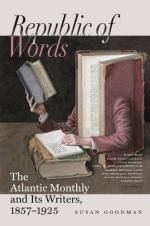A sheet of the best linen paper is dipped in salt water and suffered to dry. Then a solution of nitrate of silver is poured over it and it is dried in a dark place. This paper is now sensitive; it has a conscience, and is afraid of daylight. Press it against the glass negative and lay them in the sun, the glass uppermost, leaving them so for from three to ten minutes. The paper, having the picture formed on it, is then washed with the solution of hyposulphite of soda, rinsed in pure water, soaked again in a solution of hyposulphite of soda, to which, however, the chloride of gold has been added, and again rinsed. It is then sized or varnished.
Out of the perverse and totally depraved negative,—where it might almost seem as if some magic and diabolic power had wrenched all things from their proprieties, where the light of the eye was darkness, and the deepest blackness was gilded with the brightest glare,—is to come the true end of all this series of operations, a copy of Nature in all her sweet gradations and harmonies and contrasts.
We owe the suggestion to a great wit, who overflowed our small intellectual home-lot with a rushing freshet of fertilizing talk the other day,—one of our friends, who quarries thought on his own premises, but does not care to build his blocks into books and essays,—that perhaps this world is only the negative of that better one in which lights will be turned to shadows and shadows into light, but all harmonized, so that we shall see why these ugly patches, these misplaced gleams and blots, were wrought into the temporary arrangements of our planetary life.
For, lo! when the sensitive paper is laid in the sun under the negative glass, every dark spot on the glass arrests a sunbeam, and so the spot of the paper lying beneath remains unchanged; but every light space of the negative lets the sunlight through, and the sensitive paper beneath confesses its weakness, and betrays it by growing dark just in proportion to the glare that strikes upon it. So, too, we have only to turn the glass before laying it on the paper, and we bring all the natural relations of the object delineated back again,—its right to the right of the picture, its left to the picture’s left.
On examining the glass negative by transmitted light with a power of a hundred diameters, we observe minute granules, whether crystalline or not we cannot say, very similar to those described in the account of the daguerreotype. But now their effect is reversed. Being opaque, they darken the glass wherever they are accumulated, just as the snow darkens our skylights. Where these particles are drifted, therefore, we have our shadows, and where they are thinly scattered, our lights. On examining the paper photographs, we have found no distinct granules, but diffused stains of deeper or lighter shades.




